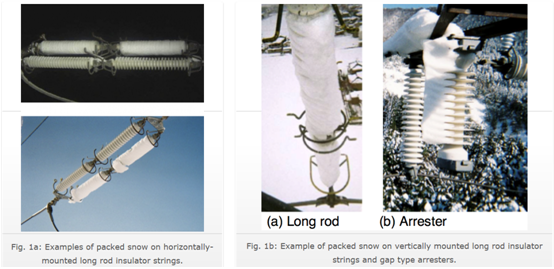On 22 Dec. 2005, a severe snowstorm in northern Japan led to one of the country’s worst long-term outages in decades and impacted the Niigata Kaetsu region supplied by Tohoku Electric Power Co. About 650,000 households were affected over a maximum duration of as much as 31 hours. For a country such as Japan, with among the highest reliability levels in the world, this was truly an extraordinary event.
The massive blackout was induced by wet snow mixed with sea salt that had packed the sheds of porcelain long rod insulators on both 66 kV and 154 kV lines. Conductor galloping along 275 kV transmission lines also contributed to the scale of the problem. In this case, the wet snow accreted on insulators and filled the gaps between sheds due to the effect of strong winds. Because the snow contained large amounts of sea salt, the insulation strength of the strings deteriorated rapidly and led to numerous flashovers – but in a way quite different from the better-known phenomena of ice accretion or snow cover on insulator strings.
While much research has been performed on ice accretion/snow accumulation on insulators, knowledge related to the effect of wet snow containing contamination such as sea salt is still comparatively rare. More research is therefore necessary to clarify the mechanisms of failure and establish the most effective countermeasures.
This INMR article from 2010 based on a contribution by Manabu Sakata of Tohoku Electric Power and Hiroya Homma of Japan’s Central Research Institute of Electrical Power Industry (CRIEPI), provided a valuable overview of the event. It also discussed the properties of wet snow accretion on insulator strings based on the results of artificial wet snow tests. All this was part of a project dealing as well with wet snow accretion on conductors as well as conductor galloping.
Introduction
In late December of 2005, a powerful low-pressure system from the Pacific moved south to north along the east coast of Japan’s main island while another similar system in the Sea of Japan crossed the island. Ambient temperatures in the Niigata Kaetsu area, on the island’s northwest, stabilized in the range of 0 to +2°C with a combination of heavy precipitation and wind. Total precipitation and maximum 10 min. average wind velocity were 26 mm and 14 m/sec respectively (with an overall maximum wind speed of over 25 m/ sec). Cascading electrical failures on 66 kV and 154 kV lines started just before 09:00 and resulted in numerous tripped lines. At the same time, some 275 kV transmission lines also began to trip out due to conductor galloping. Eventually, 30 transmission lines and 49 circuits were affected.
Maintenance workers discovered that many of the porcelain long rod insulators used on the affected 66 kV and 154 kV lines were packed with wet snow. Figs.1a and 1b show examples of this on insulator strings as well as on a gap-type arrester. The shapes of packed snow on insulators in some cases were cylindrical while in other cases were eccentric pennant into the wind direction. These shapes of snow on insulator strings are quite different from those that result from simple ice accretion or snow cover. For example, the volume density of the packed snow ranged from 0.54 to 0.94g/cm
3 while its maximum conductivity was approximately 0.2 mS/cm.


